Posted on July 31, 2003
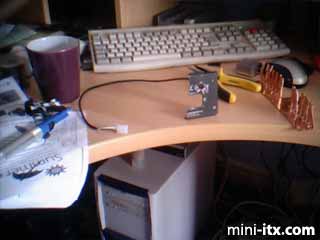
The internal power lead screwed to part of the rear panel
and the copper heat sink / transfer plate bent to shape.
I was a bit disappointed that I couldn't keep the copper
flatter while I was cutting it (as clearly the flatter
the copper the more contact there will be between it and
the CPU) but I didn't have the patience to cut the whole
thing with a hacksaw, so bought a hacksaw blade for my
jigsaw and jigged around with that for a bit.
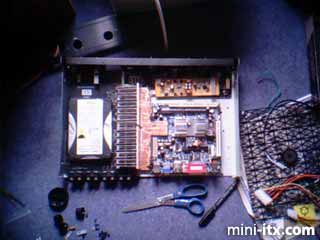
More finally positioned stuff. I drilled 4 holes in the
phono stage PCB and screwed the hard drive to it. I had
to drill an extra hole in the DC-DC converter and drilled
corresponding holes in the front board, used a couple of
nuts as spacers and bolted it in place.
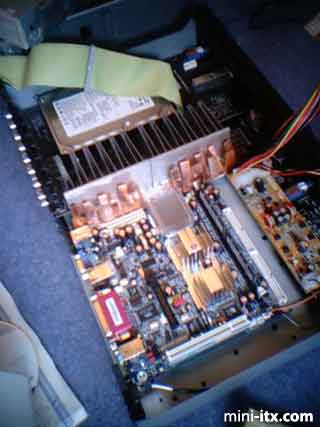
And the final product, pretty much. You can see some of the
(electrically non-conductive) heat transfer grease squeezed
out around the original heatsink (I decided that this was
the easiest and most reliable way of attaching the copper
plate to the mainboard and it would add some more heat
slinkiness. Though at this point the words "sledgehammer(s)", "crack" and "nut" were
coming to mind :) In the end I did wire up the front panel
power button to use as the power button. I realised I did
need one, and besides, you can stop the power button from
doing anything (unless you hold it down for 10 secs), So
I took the switch apart and removed the pin which makes
the switch latch, and then broke the switch with some over
zealous plier use on the reconstruction.
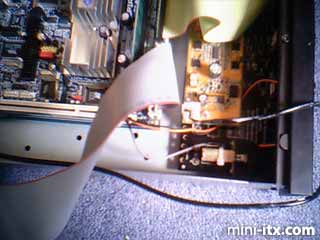
Some careful plier use and a cable tie later all was well,
and I had a power switch. Wiring up the LED and power switch
was very easy, the LED already had a suitable connector
and I used another connector from the amp and soldered
it to the switch connectors on the PCB.
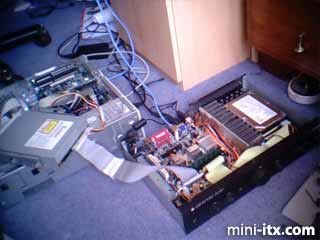
And my test setup. After I had checked and double checked
everything I could think of, I plugged the PSU in and pushed
the power button. Nothing happened. Quite a bit of swearing
happened and I drew all sorts of conclusions about damaging
the motherboard when I ripped the heatsink off, or maybe
I hadn't checked that the motherboard was properly isolated.
The first thing I did was to check that the power button worked with a multimeter, which it did, so next I checked the connection in the motherboard hand book, and sure enough I had the connector across pins 8 and 7 rather than 8 and 6. So I pressed the power button again, heard a loud click through my speakers, which I wasn't too keen on, but the monitor clicked into life and it looked happy :) I left the PC in bios on the PC Health Status screen to watch the CPU temperature, it peaked at 61 degrees, and apparently in bios the CPU is almost under maximum load, or at least gets close to the maximum temperature. After I had installed windows another check on CPU temperature revealed that it had reached 67 degrees, a bit warm for comfort, but it seems ok to me, and the heatsink wasn't even getting close to the temperature of the north and south bridge heatsink.
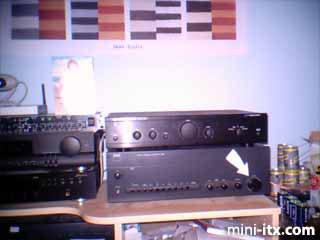
A couple of days later, once I had moved my installation
of windows and set up everything the way I wanted it, I put
the lid on and positioned the amPC in the only space I had
available, over my current amp. I'm not sure if it was having
it over the warm amp, having the cover on, the incredibly
hot weather we'd been having (this was 14th July) or the
updates that took almost 100% of the processor for about
8 minutes, probably all of the above, but it became extremely
hot. A reboot allowed me to view the CPU temperature, which
had reached 74 degrees. I quickly removed the cover and used
it to fan the board :) The whole of the aluminum heat sink
was hot to the touch, and the bridges heat sink was taking
the skin off my fingers. I was just thinking to myself the
network chip seems a bit hot, when the server seemed to stop
routing internet traffic. I could still ping it, but I wasn't
able to browse from any computer other than the server. I
decided to take the server off the amp. After restarting
all machines concerned, everything worked again, and I breathed
a sigh of relief, it was a nice breeze in my, by now, stifling
room. I wasn't looking forward to having to take it all apart
again to drill more holes in the bottom and top of the case,
adding a fan would kind of defeat the object :-/ I decided
that since the bridges heatsink was the thing that was warmest,
I should provide that with some extra ventilation.
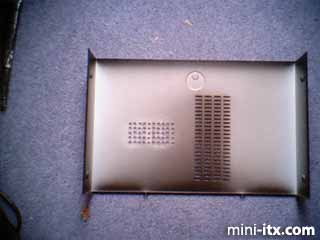
The dreaded holes weren't so scary after all :)
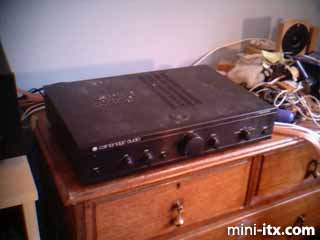
And they work splendidly :D So this is the finished product.
If you think there has been a lack of pics of its rear
end, there is a reason...
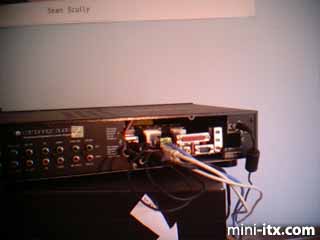
It's a bit of a pig's ear :-/ but it's functional, and I
do need to sort something out so that I can attach the
firewire/extra USB ports for when (if!) I get an iPod (yeah
I know they use USB too, but disks are up to 70% faster
with firewire compared to USB 2.0).
Conclusions
The problem with not having any fans doesn't seem to be getting the heat away from the cpu, it seems to be getting it out of the case. I did think about extending my copper T to include the Bridges (like The Hush and The Tranquil PC), but was worried that in my case, rather than help matters, it would just heat up the CPU even more.
Building a totally silent
computer is not possible! Every time you take away the loudest
thing
your ears adjust to hear
the
next loudest. I run a webcam which writes to the hard drive
once a second, so I replaced the old loud drive I had with
a Seagate Barracuda, apparently one of the quietest,
but it
was still annoying me at night (this was once I had taken
the fans away, which used to drown out even the old hard
drive) so I bought a flash drive and put the webcam software
and temp file on that. But then instead of the hard drive
seek, I could hear a clicking sound, which actually seemed
louder than the hard drive seek (the click was actually
coming from the motherboard, and was absent with my USB
1.1 flash
drive, but not the faster USB 2.0 drive). So now I use
RAM drive and have a batch file copy the software to
it on start
up. But there is still noise. The DC-DC converter has a
quiet high pitch whine, and there are lots of quiet clicks
and ticks
coming from the motherboard, none of them loud enough to
bother me while I am in bed, so the harddrive whirr is
the only thing I can hear now.
I walked into my room today to find a very happy cat asleep
on a not so happy server. Maybe I shouldn't have sanded
the burns from the holes so well :)
The site I am serving is here , though I am only on a normal broadband connection so please only visit if you are interested, thanks :)
Shout outs to me muva Sally, and Pete at Steyning Motor Spares for the nuts, bolts, screws, patience and, as always, good humour :)
Now, can anyone provide a good home
to some transistors and a toroidal transformer for a
Cambridge Audio A4? Think
you'll have to pay the postage on the toroidal though :)
and if anyone would like to commission me to make an ITX
out of a cd player I think it would be the perfect case
- cd
tray, display window and buttons you can actually do useful
things with, though no heatsinks, so you'd have to have some
fans hanging around...
 |
 |
 |
Quick Links
Mailing Lists:
Mini-ITX Store
Projects:
Show Random
Accordion-ITX
Aircraft Carrier
Ambulator 1
AMD Case
Ammo Box
Ammo Tux
AmmoLAN
amPC
Animal SNES
Atari 800 ITX
Attache Server
Aunt Hagar's Mini-ITX
Bantam PC
BBC ITX B
Bender PC
Biscuit Tin PC
Blue Plate
BlueBox
BMW PC
Borg Appliance
Briefcase PC
Bubbacomp
C1541 Disk Drive
C64 @ 933MHz
CardboardCube
CAUV 2008
CBM ITX-64
Coelacanth-PC
Cool Cube
Deco Box
Devilcat
DOS Head Unit
Dreamcast PC
E.T.PC
Eden VAX
EdenStation IPX
Encyclomedia
Falcon-ITX
Florian
Frame
FS-RouterSwitch
G4 Cube PC
GasCan PC
Gingerbread
Gramaphone-ITX-HD
GTA-PC
Guitar PC
Guitar Workstation
Gumball PC
Hirschmann
HTPC
HTPC2
Humidor 64
Humidor CL
Humidor II
Humidor M
Humidor PC
Humidor V
I.C.E. Unit
i64XBOX
i-EPIA
iGrill
ITX Helmet
ITX TV
ITX-Laptop
Jeannie
Jukebox ITX
KiSA 444
K'nex ITX
Leela PC
Lego 0933 PC
Legobox
Log Cabin PC
Lunchbox PC
Mac-ITX
Manga Doll
Mantle Radio
Mediabox
Mega-ITX
Micro TV
Mini Falcon
Mini Mesh Box
Mini-Cluster
Mobile-BlackBox
Moo Cow Moo
Mr OMNI
NAS4Free
NESPC
OpenELEC
Osh Kosh
Pet ITX
Pictureframe PC
Playstation 2 PC
Playstation PC
Project NFF
PSU PC
Quiet Cubid
R2D2PC
Racing The Light
RadioSphere
Restomod TV
Robotica 2003
Rundfunker
SaturnPC
S-CUBE
SEGA-ITX
SpaceCase
SpacePanel
Spartan Bluebird
Spider Case
Supra-Server
Teddybear
Telefunken 2003
TERA-ITX
The Clock
ToAsTOr
Tortoise Beetle
Tux Server
Underwood No.5
Waffle Iron PC
Windows XP Box
Wraith SE/30
XBMC-ION
